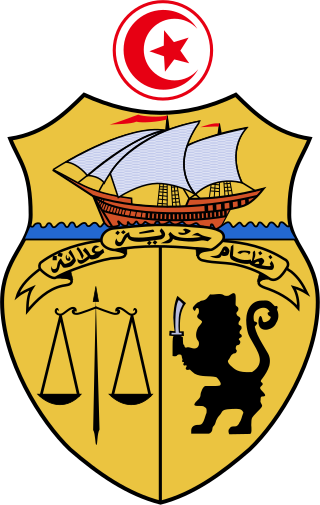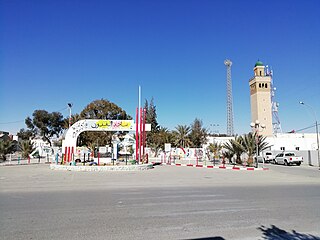
The Tunisian Sahel or more precisely the Central East Tunisia is an area of central eastern Tunisia and one of the six Tunisian regions. It stretches along the eastern shore, from Hammamet in the north to Mahdia in the south, including the governorates of Monastir, Mahdia, Sfax and Sousse. Its name derives from the Arabic word sāḥil (ساحل), meaning "shore" or "coast". The region's economy is based especially on tourism and it contains the second-biggest airport in Tunisia: Monastir Habib Bourguiba International Airport.

Monastir, also called Mestir, is a city on the central coast of Tunisia, in the Sahel area, some 20 kilometres south of Sousse and 162 kilometres south of Tunis. Traditionally a fishing port, Monastir is now a major tourist resort. Its population is about 93,306. It is the capital of Monastir Governorate.

Sousse or Soussa is a city in Tunisia, capital of the Sousse Governorate. Located 140 km (87 mi) south of the capital Tunis, the city has 271,428 inhabitants (2014). Sousse is in the central-east of the country, on the Gulf of Hammamet, which is a part of the Mediterranean Sea. Its economy is based on transport equipment, processed food, olive oil, textiles, and tourism. It is home to the Université de Sousse.

Enfidha is a town in north-eastern Tunisia with a population of approximately 10,000. It is visited by tourists on their way to Takrouna. It lies on the railway between Tunis and Sousse, approximately 45 km northeast of Sousse and a few kilometres inland from the Gulf of Hammamet. The nearby Enfidha – Hammamet International Airport opened in 2009, serving charter flights from several European countries.

Sousse Governorate is one of the twenty-four governorates (provinces) of Tunisia. It is beside the eastern coast of Tunisia in the north-east of the country and covers an area of 2,621 km2 and has a population of 674,971. The capital is Sousse.

The delegations of Tunisia are the second level administrative divisions of Tunisia between the governorates and the sectors (imadats). As of 2006 there were 24 governorates which were divided into 264 delegations and further divided into 2073 sectors. The delegations are listed below, organized by governorate.

The Bardo National Museum is a museum of Tunis, Tunisia, located in the suburbs of Le Bardo.

Tourism in Tunisia is a major industry, attracting around 9.4 million arrivals annually from the year 2016 to 2020, making it one of the most visited countries in Africa.

The Sousse Archaeological Museum is an archaeological museum located in Sousse, Sousse Governorate, Tunisia.

Métlaoui is a town and commune in the Gafsa Governorate, Tunisia. In 2014 it had a population of 39,100.

The University of Sousse is a public university in Sousse, Tunisia.
The following lists events that happened during 2015 in the Tunisian Republic.

On 26 June 2015, a mass shooting occurred at the tourist resort at Port El Kantaoui, about 10 kilometres north of the city of Sousse, Tunisia. Thirty-eight people, 30 of whom were British, were killed when a gunman, Seifeddine Rezgui, attacked a hotel. It was the deadliest non-state attack in the history of modern Tunisia, with more fatalities than the 22 killed in the Bardo National Museum attack three months before. The attack received widespread condemnation around the world. The Tunisian government later "acknowledged fault" for slow police response to the attack.
On 24 November 2015, a bus carrying Tunisian presidential guards exploded, killing 12, on a principal road in Tunis, Tunisia. ISIL claimed responsibility for the attack. The bomber, who also died in the attack, was identified as Houssem Abdelli.
The 2016 CAF Confederation Cup group stage was played from 17 June to 24 August 2016. A total of eight teams competed in the group stage to decide the four places in the knockout stage of the 2016 CAF Confederation Cup.

The Great Mosque of Sousse is a historical mosque in the coastal city of Sousse, Tunisia. The construction dates back to 851, during the rule of the Aghlabid dynasty, vassals of the Abbasid Caliphate. It was commissioned by the ruler Abu al-‘Abbas Muhammad al-Aghlabi. It is a major monument of Aghlabid architecture in the early Islamic period. The mosque was renovated and its prayer hall expanded multiple times over the following centuries.

Ribat of Sousse is a ribat in the city of Sousse, Tunisia. Although scholars differ on the chronology of its original construction, it was most likely founded in the 8th century and reconstructed or completed in its current form during the early 9th century, under the Aghlabid dynasty. Although a large number of ribats were built in the region during that period, the Ribat of Sousse is by far the best-preserved.

Tunisian MiniFootball Federation is the governing body of minifootball in Tunisia. It was established in 2016. It became a member of the WMF in 2016, and joined AMF association the same year. It organises Tunisia Super League Elite, controls Tunisia national minifootball team and Tunisia women's national minifootball team.

The architecture of Tunisia began with the ancient civilizations such as the Carthaginians, Numidians, and Romans. After the 7th century, Islamic architecture developed in the region under a succession of dynasties and empires. In the late 19th century French colonial rule introduced European architecture, and modern architecture became common in the second half of the 20th century. The southern regions of the country are also home to diverse examples of local vernacular architecture used by the Berber (Amazigh) population.

















